Hello Fellas! Hope you’re well today. Happy to see you around. In this post today, I’ll walk you through the Introduction to D13007K. The D13007K is an NPN power transistor mainly used for switching and amplification purpose. This device is made of silicon material and falls under the category of bipolar junction transistors. As this is an NPN transistor so here major charge carriers are electrons. Holes are major carriers in the case of PNP transistors. This is a high voltage high current capability device used in energy-saving lamps. The collector current of this chip is 8A which means it is best for loads under 8A. And the power dissipation is 80W which projects it is eligible to release 80W power during the operation of this device. The collector-base voltage is 700V and collector-emitter voltage is 400 while the voltage across the base and emitter terminals is 9V which is the voltage needed to start the transistor action and bias the device. Read this entire post till the end as I’ll document the complete Introduction to D13007K covering datasheet, pinout, power ratings, working principle, applications, and physical dimensions. Let’s dive in.
Introduction to D13007K
- The D13007K is a power transistor that belongs to the NPN transistor family.
- The three terminals like emitter, base, and collector make this entire device. All these terminals are connected to the external electrical circuit.
- This is a current-controlled device because the small current at one terminal is employed to handle large current at the remaining terminals.
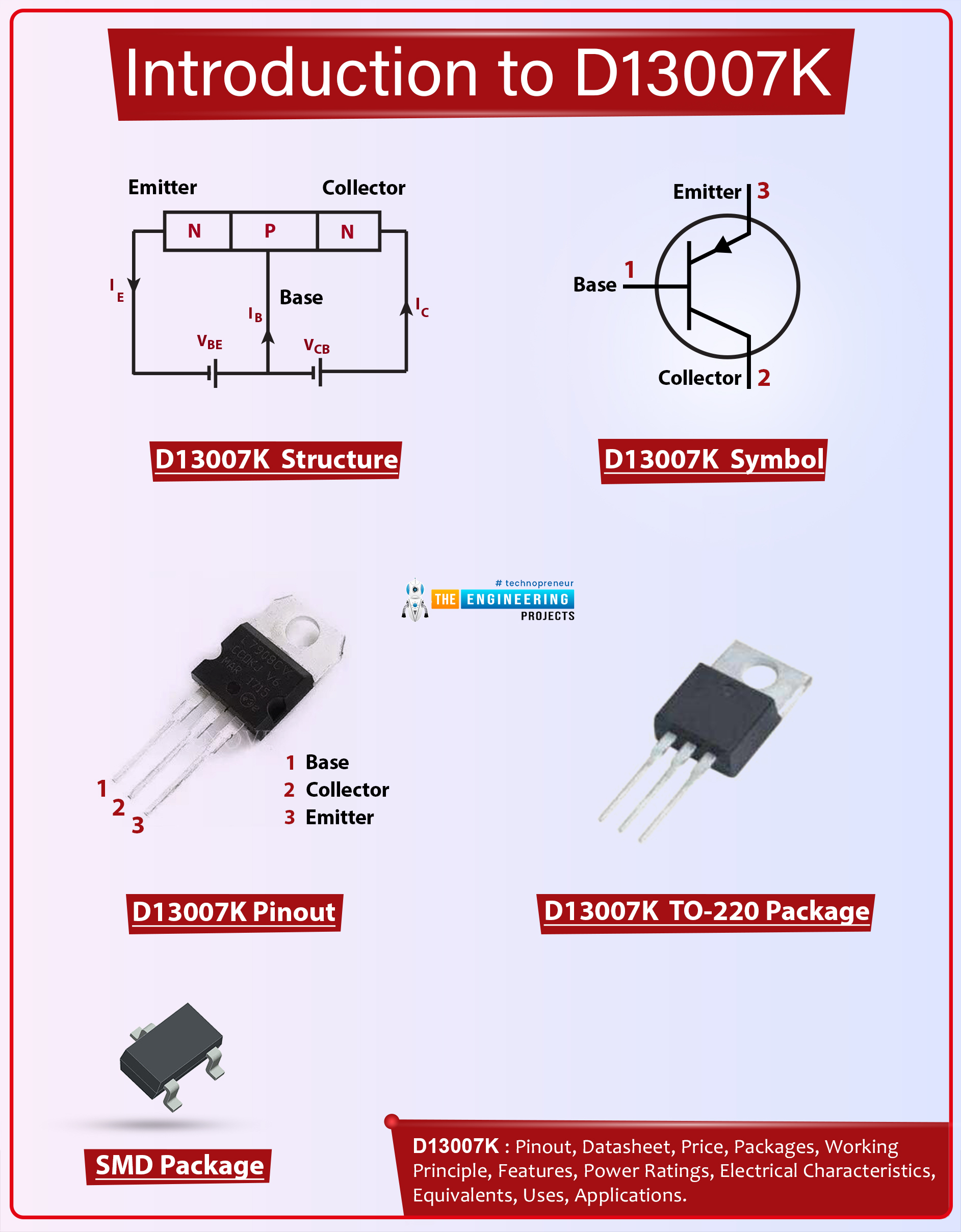
- While MOSFETs are voltage-controlled devices and come with terminals like a drain, source, and gate. The gate plays the same role in MOSFETs as what base plays in bipolar junction transistors.
- The bipolar junction transistors are mainly divided into two types one is PNP transistors and one is NPN transistors.
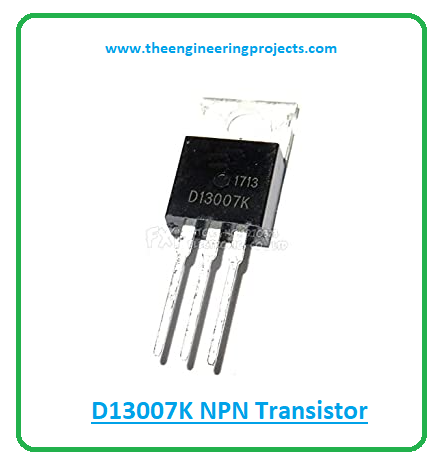
- Both electrons and holes play a key role in the conductivity of bipolar junction transistors.
- But in the case of PNP transistors holes are responsible for the major part of conductivity carried out inside the device while in the case of NPN transistors electrons play a key role in the overall conductivity inside the transistor.
- PNP transistors are considered less efficient than NPN transistors because electrons are quicker and efficient in the conductivity process compared to holes. The mobility of electrons is far better and quicker than the mobility of holes inside the transistor.
D13007K Datasheet
It is wise to check out the datasheet of the device before incorporating it into your electrical project. The datasheet comes with the main characteristics of the device. Click the link below to download the datasheet of D13007K.D13007K Pinout
The following figure shows the pinout diagram of D13007K.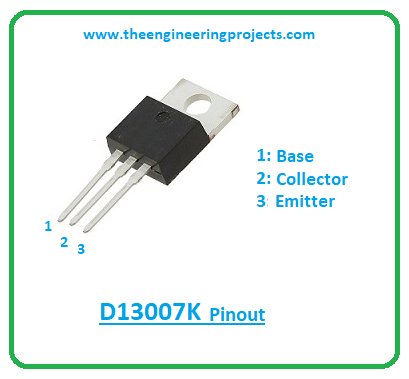
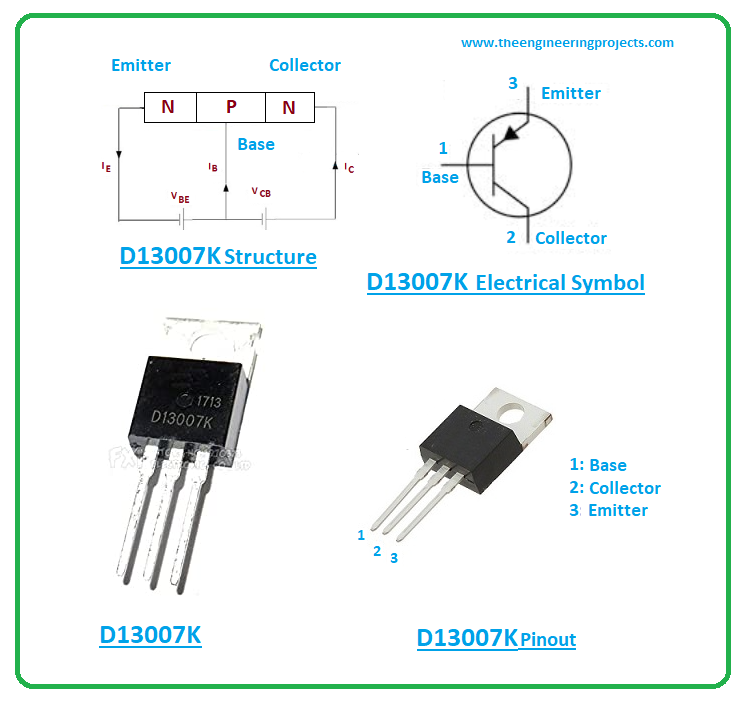
D13007K Working Principle
- The transistor working principle is straightforward and simple. It all initiates from the base side. When voltage is applied at the base side, it will bias the device, and as a result, the current will start flowing collector to the emitter terminal.
- As this is an NPN transistor so here current flow is carried out from the collector to emitter terminals this is the opposite in the case of PNP transistors.
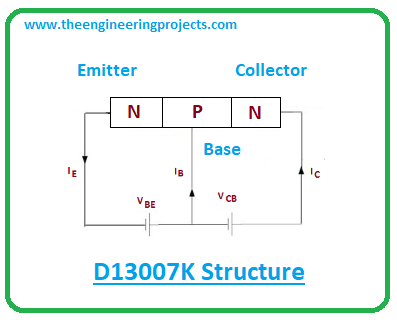
- When voltage is applied at the base pin in PNP transitory, the current starts flowing from the emitter to the collector terminal.
- As described earlier this bipolar device is not symmetrical. Which means if you interchange both emitter and collector side then both terminals will start working in reverse active mode and the device will stop working in forward active mode.
D13007K Power Ratings
The following table features the absolute maximum ratings of D13007K.| Absolute Maximum Ratings of D13007K | ||||
|---|---|---|---|---|
| Pin No. | Pin Description | Pin Name | ||
| 1 | Collector-emitter voltage | 400V | ||
| 2 | Collector-base voltage | 700V | ||
| 3 | Base-emitter voltage | 9V | ||
| 4 | Collector current | 8A | ||
| 5 | Power dissipation | 80W | ||
| 6 | Base current | 4A | ||
| 7 | Operating and storage junction temperature range | -55 to 150C | ||
- While incorporating this device into your project, make sure the ratings don’t exceed the absolute maximum ratings. Otherwise, it can damage the entire project.
- The junction temperature and storage temperature ranges from -55 to 150C.
- The collector-emitter and collector-base voltages are 400V and 700 respectively. And total power dissipation is 80W which demonstrates the amount of power released during the functioning of this device.
- It is important to note that, don’t apply these ratings more than the required time, else they can affect device reliability.
D13007K Applications
D13007K is used in the following applications.- Used in Bistable and Astable multivibrators circuit.
- Used in voltage regulator circuits.
- Employed to support loads under 12A.
- Used in electronic Ballasts.
- Incorporated in modern electronic circuits.
- Used in high-frequency power transform.
- Used in a common power amplifier.
- Used in energy-saving lights.
- Used in the high switching power supply.
D13007K Physical Dimensions
The image below represents the physical dimensions of D13007K.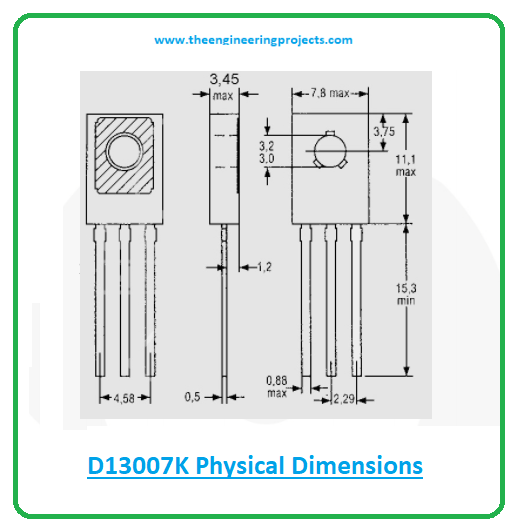



 Electronic Components
Electronic Components jameswilson
jameswilson 0 Comments
0 Comments


















 2.3k
2.3k
 953
953
 921
921
 2.1K
2.1K

